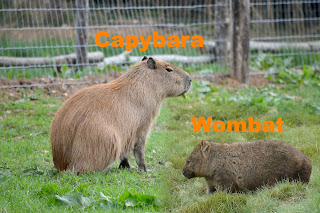When it comes to the animal kingdom, there’s a vast diversity of species that roam our planet. Among these creatures, capybaras and wombats stand out as intriguing and unique animals. In this article, we will delve into the difference between capybara and wombat, exploring their physical characteristics, habitats, behaviors, and more. Let’s embark on a journey to understand these remarkable creatures better.
 |
||
| Difference Between Capybara and Wombat. |
Capybara vs. Wombat: An Overview
Physical Appearance
Capybaras:
 |
| Capybara. Photo by Marian Havenga |
Capybaras are the largest rodents in the world, resembling giant guinea pigs. They have long, sturdy bodies covered in coarse, brownish-red fur. Their eyes and ears are small, and they possess webbed feet that aid them in swimming.
Wombats:
 |
| Wombat. Photo by Sébastien Vincon |
Wombats, on the other hand, are marsupials native to Australia. They have stout, bear-like bodies with stocky legs. Wombats have thick, coarse fur, which can range in color from gray to brown. One of their distinguishing features is their cube-shaped feces.
Habitat
Capybaras:
Capybaras are primarily found in South America, inhabiting regions such as the Amazon Rainforest and wetlands. They are semi-aquatic and are often seen near water bodies like rivers and lakes.
Wombats:
Wombats are endemic to Australia, where they occupy various habitats, including forests, grasslands, and alpine regions. They are excellent burrowers and often create extensive tunnel systems.
Diet
Capybaras:
Capybaras are herbivores, primarily feeding on aquatic plants, grasses, and fruits. Their diet is rich in fiber, making them adapted to a herbivorous lifestyle.
Wombats:
Wombats are also herbivores, consuming a diet mainly consisting of grasses, roots, and shrubs. They have strong, chisel-like teeth for efficiently grinding plant material.
Social Behavior
Capybaras:
Capybaras are highly social animals, often living in groups called “herds” or “troops.” They have a peaceful nature and engage in mutual grooming, which strengthens social bonds.
Wombats:
Wombats are solitary creatures, preferring a more independent lifestyle. They are territorial and mark their territories with scent markings.
Key Differences
Now that we’ve covered the basics, let’s dive deeper into the differences between capybaras and wombats.
Reproduction
Capybaras:
Capybaras reproduce sexually, with a gestation period of around 150 days. They give birth to litters of up to eight pups, which they care for communally.
Wombats:
Wombats, being marsupials, give birth to undeveloped live young, which then continue to develop in the mother’s pouch. They usually have only one offspring at a time.
Unique Features
Capybaras:
Capybaras are excellent swimmers and can remain submerged for several minutes. Their webbed feet and streamlined bodies make them well-suited to aquatic environments.
Wombats:
Wombats are known for their remarkable ability to dig burrows efficiently. They have strong claws and a keen sense of smell, aiding in their burrowing activities.
Geographic Distribution
Capybaras:
Capybaras are mainly found in South America, with the highest population densities in countries like Brazil, Venezuela, and Colombia.
Wombats:
Wombats are exclusive to Australia, inhabiting various regions across the continent, including Tasmania.
Difference Between Capybara and Wombat: A Detailed Comparison
| Aspect | Capybara | Wombat |
|---|---|---|
| Physical Appearance | – Largest rodents globally – Brownish-red fur – Webbed feet for swimming |
– Stout, bear-like body – Coarse fur, gray to brown – Cube-shaped feces |
| Habitat | – South America (Amazon, wetlands) – Semi-aquatic |
– Australia (forests, grasslands) – Excellent burrowers |
| Diet | – Herbivores (aquatic plants, fruits) | – Herbivores (grasses, roots, shrubs) |
| Social Behavior | – Highly social in groups (herds) | – Solitary, territorial |
| Reproduction | – Sexual reproduction – Litters of up to eight pups |
– Marsupial (live young in pouch) – Usually one offspring at a time |
| Unique Features | – Excellent swimmers – Webbed feet for aquatic life |
– Efficient burrowers – Strong claws, keen sense of smell |
| Geographic Distribution | – South America (Brazil, Venezuela) | – Exclusive to Australia (Tasmania) |
FAQs
Q: Are capybaras and wombats endangered species?
A: Capybaras are not considered endangered, while some wombat species are vulnerable due to habitat loss and road accidents.
Q: Can capybaras and wombats be kept as pets?
A: In most places, keeping capybaras or wombats as pets is either illegal or requires special permits due to their unique needs and potential dangers.
Q: Are capybaras and wombats related to each other?
A: No, capybaras and wombats belong to different taxonomic families. Capybaras are rodents, whereas wombats are marsupials.
Q: What is the average lifespan of capybaras and wombats in the wild?
A: Capybaras can live up to 8-10 years in the wild, while wombats have a slightly longer lifespan of 10-15 years.
Q: Do capybaras and wombats have any natural predators?
A: Capybaras’ main predators include jaguars and caimans, while wombats are primarily threatened by dingoes and Tasmanian devils.
Q: Can capybaras and wombats coexist in the same habitat?
A: No, capybaras and wombats are native to different continents and do not share the same habitat.
In conclusion, capybaras and wombats are captivating creatures with distinct characteristics, behaviors, and habitats. While capybaras thrive in the lush landscapes of South America, wombats have carved out their unique niche in the Australian wilderness. Their differences in appearance, diet, social behavior, and geographic distribution make them fascinating subjects for study and appreciation.
As we’ve explored the difference between capybara and wombat in this article, we hope you’ve gained a deeper understanding of these remarkable animals. Whether you’re drawn to the gentle, communal nature of capybaras or the solitary, burrowing lifestyle of wombats, both species contribute to the rich tapestry of our planet’s biodiversity.